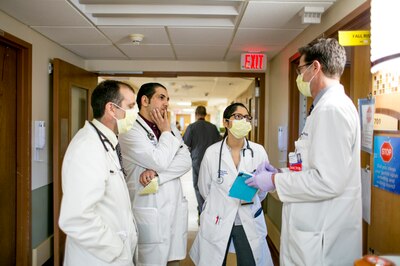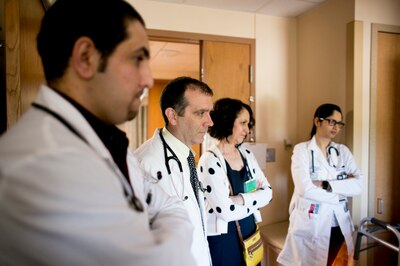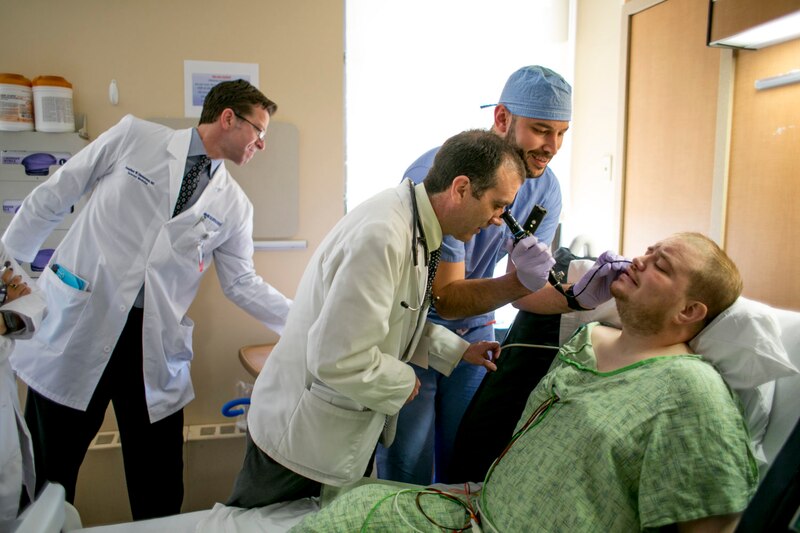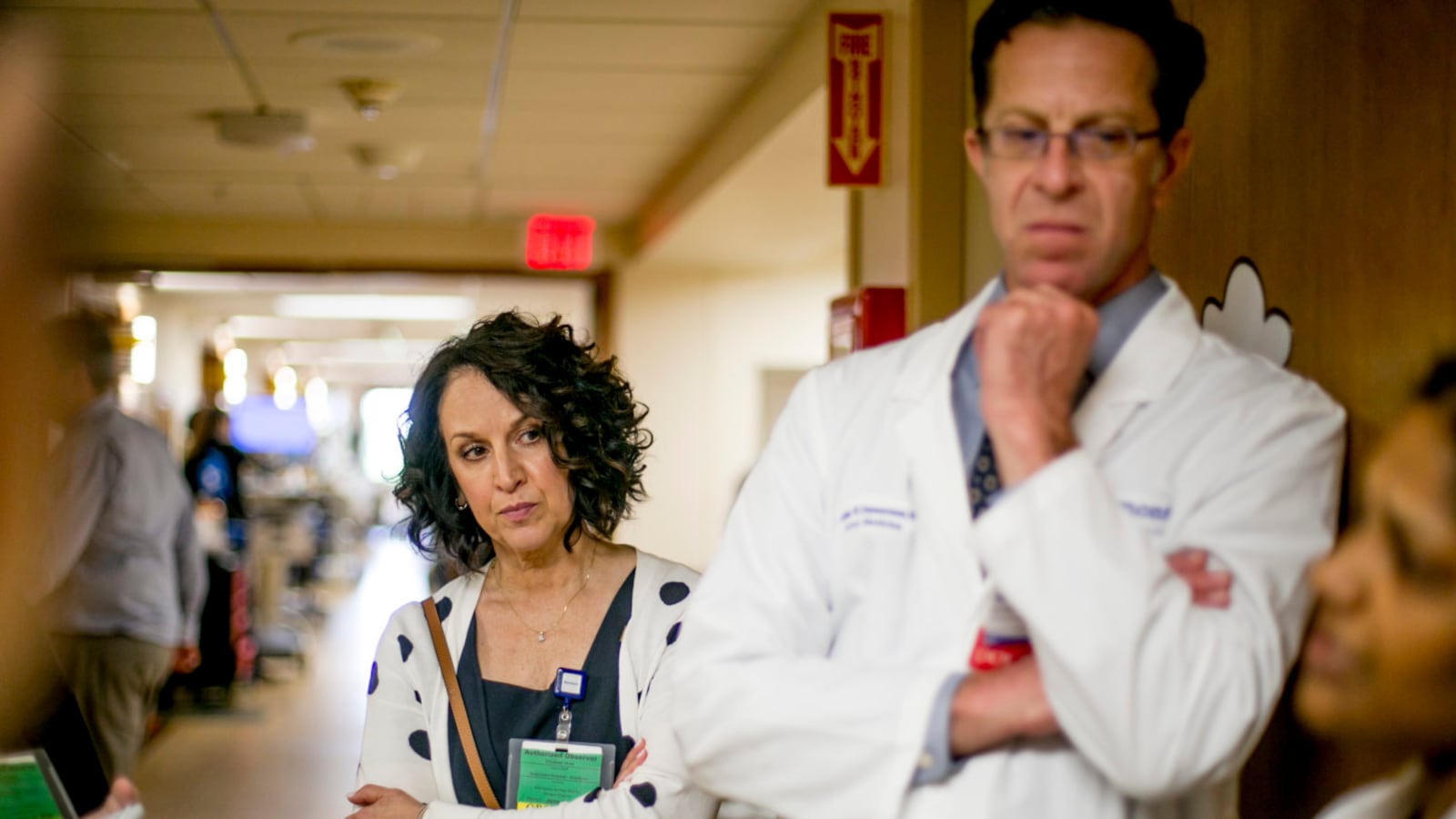After decades of training teachers in largely the same way, professors at the University of Michigan are making a radical change.
They’re moving to end the longtime practice of sending educators into their own classrooms after just a few months of student teaching.
In its place, they’re creating a new method — one based on the way doctors are trained — that will extend teacher training through their first three years on the job, supporting them as they take on the daunting responsibility of educating children.
“It was very nerve-wracking,” said Lisa Murray, who just finished her second year as an English teacher at Detroit’s Munger Elementary-Middle School.
Before starting at Munger, she’d spent 14 weeks as a student teacher in a fourth-grade classroom but suddenly found herself teaching seventh-grade English. She had a supportive mentor at her new school, she said, but “ultimately you kind of have to figure it out. It’s kind of trial and error.”
That’s how teacher training has been for generations, said Elizabeth Moje, the dean of the school of education at the University of Michigan.
“That’s what I did,” Moje said of her intimidating first teaching job when she was 21. “It’s what teachers do — and it’s ludicrous.”
Moje hopes her new approach will not only lead to better outcomes for kids, but will keep teachers in the classroom longer at a time when one in ten are leaving the profession after their first year.
She’s particularly hoping to keep teachers working in urban schools where students are more likely to be academically behind, but where limited resources for supporting teachers means that as as many as 35 percent of new teachers leave the profession after their first year.
The new approach involves this: A K-12 teaching school, similar to a teaching hospital, where future teachers — called interns — will train together under a single roof.
They’ll complete their student teaching there. Then, instead of heading out in search of a job in another school, they’ll stay on for three more years as full-time, fully certified teaching “residents.”
Residents won’t be trainees. They’ll be real classroom teachers working with real children and making a real salary — the same as any other first-, second-, or third-year teacher. But, unlike their peers in traditional schools, they’ll continue to learn from their professors and will work closely with the veteran teachers — called attendings — who will make up most of the school’s teaching staff.
Moje hopes to launch the teaching school as a partnership with a school or district in or near Detroit as soon as the fall of 2019.
Once it’s up and running, she said, she expects that between half and two-thirds of the faculty will be veteran teachers. The rest will be residents.
Details are still being ironed out, including the specifics about which school or district will partner with the university on the effort. But one option is the main Detroit district, where Superintendent Nikolai Vitti said he’s been in “active conversations” with Moje.
“We are confident that something will be announced shortly about our plans,” he said. “The residency program is exactly what we need during a time when many teachers are not provided with the right support and training to assume responsibility of improving student performance, especially in Detroit.”
Vitti added that he thinks a program like this would recruit high-quality candidates to teach in Detroit and keep them in city schools.
***

Moje is not the first to call for teacher training to look more like medical training.
Even as the trend in education in recent years has tilted toward accelerated certification programs like Teach for America that give non-education majors a crash course in teaching before placing them in a classroom, research has shown that if teachers aren’t well prepared and supported, they’re more likely to burn out and quit.
Teacher turnover — a problem that’s especially acute in schools with fewer resources to support new teachers — can exacerbate the very teacher shortages that alternative certification programs like Teach For America and the for-profit Teachers of Tomorrow are designed to address.
That’s why some districts and charter school networks in recent years have started year-long residency programs that are similar to student teaching but involve an entire school year.
Some schools have hired new teachers as “associates” before letting them fly solo in a classroom. The Denver school district has a new program that lets a handful of new teachers spend their first year working part-time in a classroom and using the rest of their time to plan, observe and hone their craft.
But Moje’s concept — the idea of extending teacher training for three years— is one that experts say is a novel approach that’s worth watching.
Because the residents are paid members of the school staff, the model doesn’t rely on private donations, or ask teachers to do extra training on their own dime.
“It’s exciting,” said Maria Hyler, a senior researcher for the Learning Policy Institute, an education think tank. “It fits into a lot of what’s going on in teacher prep right now, but on steroids, which is fabulous!”
Hyler noted that 30-50 percent of teachers leave the profession in the first three years, “often because of challenging working conditions or lack of preparation” so it makes sense to support them through that time.
Karen DeMoss, who directs the Prepared To Teach program at Bank Street College, said she questioned how this model could work for large teaching colleges that bring in more candidates than they’re likely to have jobs for in any one teaching school. But she said she’ll be watching with interest to see how this model plays out for Michigan.
“I love the idea that an institution is committing to every single student having access to this kind of extended learning experience to learn how to do one of the most complicated jobs around,” she said.
***

Moje’s teaching school concept began in earnest around 2010 when Dr. Jonathan Zimmerman, who was the residency director for internal medicine at Beaumont Hospital-Dearborn, reached out to Moje and her colleague, Bob Bain, at Michigan’s education school for help developing a new evaluation tool for medical residents.
A partnership soon emerged that had Moje joining Zimmerman on medical rounds in the hospital and Zimmerman joining Moje to observe teachers training at Detroit’s Cody High School.
The two soon noticed key differences in the way their students are taught.
At Cody, for example, Zimmerman noted a classroom where a seasoned teacher was working with four student teachers.
The classroom teacher had divided her high school students into four groups and had assigned a student teacher to lead each group.
“I saw them doing the very best they could to get the students to pay attention to a project,” Zimmerman said of the student teachers, but while all of the student teachers were focused on the teens they were working with, none of them were watching each other.
The classroom teacher circulated to each of the small groups, but she could only see one group at a time so the other three student teachers were largely on their own.
“They were all engaged in independent practice, which is great,” Moje said. But all of the student teachers were in the first semester of their training. Most had not yet developed much skill, so three of them at any time could have been doing something wrong “and no one would know,” she said.
In contrast, medical students, interns, residents, and attendings visit patients together in daily hospital rounds. Everyone has a role to play that includes learning from the person ahead of them in their training, and teaching the person coming up behind them.
“A third-year medical student is almost always paired at the hip with an intern,” Zimmerman said. “It’s much easier to learn from a peer that’s one or two years ahead of you and it’s much easier to teach if you are teaching somebody one or two years behind you. You have a better sense of where they’re coming from and they’re not so scared. ”
When Moje and Zimmerman were on rounds one day last month at Beaumont-Dearborn, they were accompanied by a fourth-year medical student, a first-year resident (called an intern) and a second-year resident.
As the team visited a patient with a severe inflammation of the pancreas, Zimmerman asked David Dimcheff, the medical student, what he thought the patient needed next.
“We treat with antibiotics,” Dimcheff responded.
Ok, Zimmerman said but, “what are the other options?”
Dimcheff looked confused. He froze for a minute, thinking, then glanced across the patient’s bed to where the two residents, Pooja Modi and Ahmed Ali, were making a hand gesture that looked like pulling a thread from a piece of fabric.
Dimcheff hesitated until the gestures made sense.
“We could get a sample with a fine needle aspiration and determine what bacteria is causing the infection,” he said. “That would help us tailor our antibiotic treatments.”
Yes, Zimmerman said, “and it would also help us ascertain whether or not [the pancreas] is actually infected.”
Moje noted later that her student teachers at Cody didn’t have residents to turn to if they were struggling.
They were “working independently and not having the kind of support that [Zimmerman’s] team has,” Moje siad. “His fourth-year med student, David, always has somebody more senior to him and our students don’t.”
Moje believes her teaching school can change that.
She’s designing the school so that as resident teachers improve, they’ll help train teachers coming up behind them. They’ll attend classes and workshops that could be held in the school building. And they’ll participate in meetings similar to what hospitals call “grand rounds,” where doctors, residents and medical students gather to discuss the condition of patients and the best course of treatment.
“One day you might be in a classroom with a student teacher and an attending, and a [university] field instructor might also be present, and a faculty member would show up, especially if we’re teaching classes there,” Moje said. “The next day, you might be in the exact same classroom and the student teacher is in a different classroom, but the attending is there.”
The new model will simplify a lot of things for the university’s school of education, which last year had student teachers working in 356 classrooms scattered around southeastern Michigan, Moje said. The university also has interns doing observations in classrooms for several months before their student teaching begins.
“We can’t be there every day,” she said. “The advantage of the teaching school is that they’ll be in one location so we’ll be able to concentrate a lot more of our time and attention on these interns. That’s also why we can continue to support the residents because they’ll all be in one place.”
By offering college classes in the teaching school building, students can work toward their bachelor’s degree — or pursue a master’s — without having to drive between a Detroit school and a college lecture hall 45 minutes away in Ann Arbor.
When interns first start out, they’ll rotate to different teachers’ classrooms and slowly take on more responsibility.
“A first semester intern might be in a classroom with a teaching resident for part of the day, and in a classroom with an attending teacher for part of the day,” Moje said. “While in medicine, doctors move from patient to patient, in our clases they’ll be attached to a third-grade classroom. But, for part of the day, the teaching resident is leading and the other part, the attending is leading.”
All future teachers “would see a high level of practice,” she said, and all of the extra hands in the building will enable educators of all stages to leave their classrooms to supervise junior teachers or to watch a senior teacher work.
After three years on staff in the teaching school, residents will leave as fourth-year teachers who have been trained to weather the intensive challenges of teaching in urban schools.
That’s how Moje believes her school can potentially impact the quality of instruction across a city like Detroit.
“The gamble we’re all making,” Moje said, is that residents will move on from this teaching school and take jobs in other urban schools. “We’ll start to build a sense of scale because we’re distributing the talent pool to all these other schools.”
***

Moje’s vision is to eventually have at least two teaching schools — one in an urban area like Detroit and the other near the university’s main campus in more affluent Ann Arbor.
“We hope this will recruit large numbers of people who want to do something very different in terms of teacher education,” she said. ”As the school grows and gains more stature, we hope it will also draw people into teaching.”
The new teaching school could be a tough sell for some parents who might fear that the new model is too experimental, or that educating their children would take a back seat to the demands of training teachers. But Moje said children will get a lot more attention in this school than they would in a typical school.
She believes children will benefit from efficiencies like those created in the hospital when doctors and med students work together.
As Zimmerman and his team made their way around the hospital last month, Zimmerman had the group stop to watch an ear, nose, and throat specialist use a scope to examine a patient’s vocal chords, making sure that Dimcheff, the medical student, got a chance to look through the scope.
He stopped an infectious disease specialist to request an impromptu hallway lecture on bacterial growth. And when the team emerged from the room of a 91-year-old patient who’d developed a bleeding ulcer when drugs he was taking for a heart condition interacted with drugs he was prescribed for shoulder pain, Zimmerman held the group in the hallway for almost 20 minutes, questioning each member about learnings from that patient.
In some ways, stopping to teach is inefficient, he said, but the work interns and residents do in the hospital more than makes up for the time spent teaching them.
“They’re admitting all the patients,” he said. “Putting orders into the computer, following up on [test results], getting a consultant to come see the patient, gathering everybody’s opinion, talking to the family, talking to the patient over and over, checking with them over and over again.”
Moje said she envisions her teaching school working the same way.
“It’s very rare that attending teachers, or any teachers, have the time to do this kind of on-the-job teaching of teachers,” Moje said as she watched Zimmerman and his team.
“That’s one of the things we’re trying to think through,” she said. “What would it mean if we made what we’re now calling attending teachers able to move around the building more? And be able to pop in and work with a novice teacher? With a teaching resident? With a student teacher? An intern? What would we have to do structurally?”
Murray, the English teacher at Detroit’s Munger Elementary-Middle school was intrigued by the idea of teachers getting more support in their first years.
Ultimately, she said, she’s found ways to serve her students. In her second year, the main Detroit school district honored her as its rookie teacher of the year.
“I had a better understanding of how I can run my classroom,” she said. “A better understanding of the curriculum.”
But she fondly remembers the support she had from her college professors and liked the idea of formal support continuing into a teacher’s first years.
“Teaching is one of those careers that no one can ever really prepare you for,” she said.
But once you’re in a school, doing the work, “to be able to have all these connections, all these professors, and all the people I had the support from in college … That could be really powerful.”

